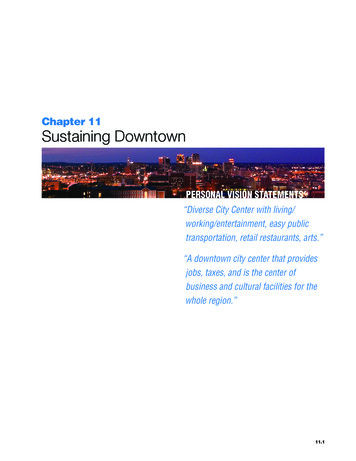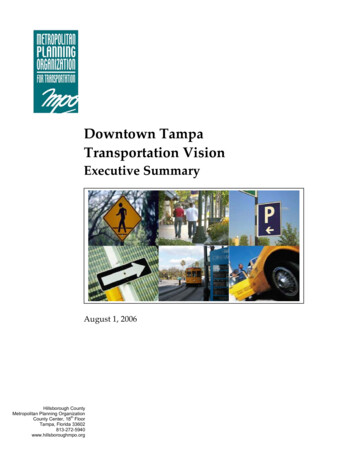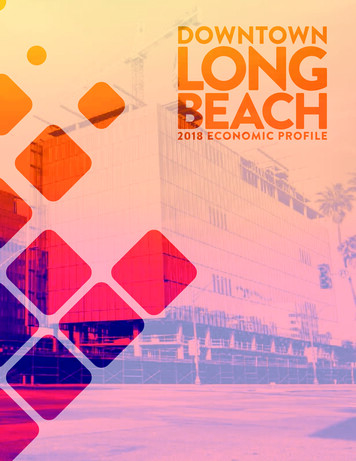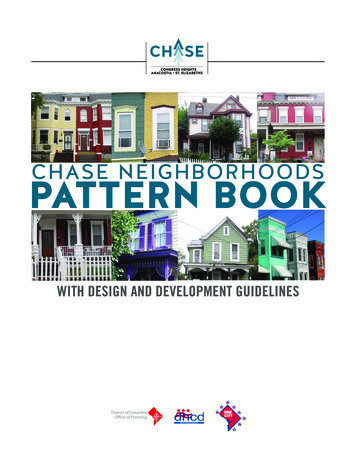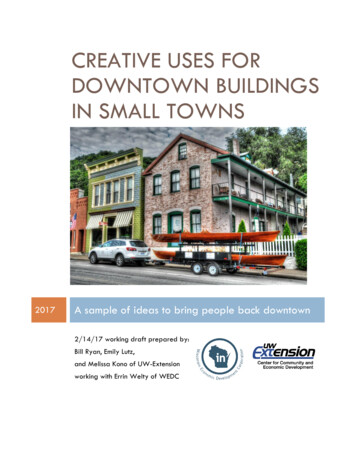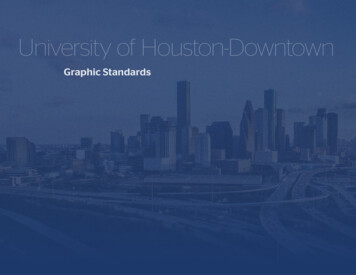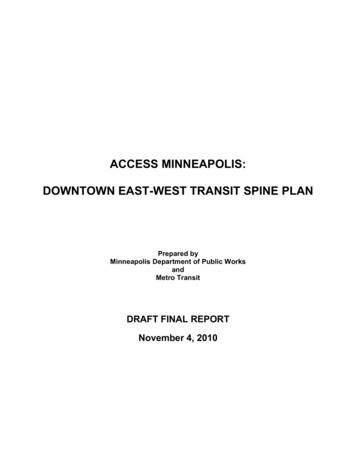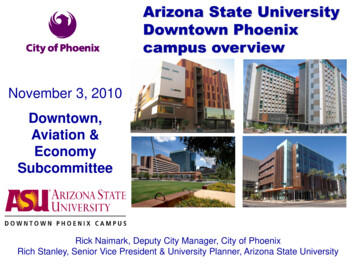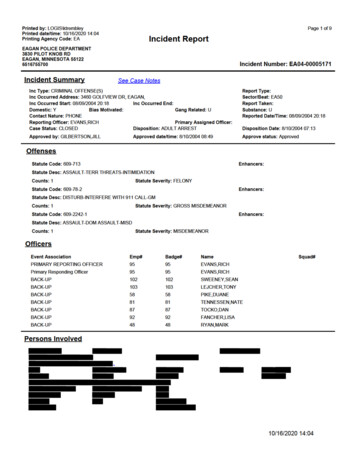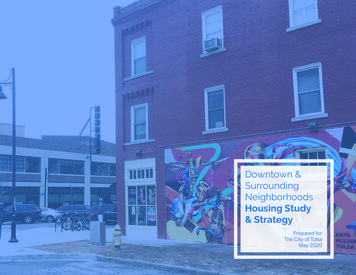
Transcription
Prepared forThe City of TulsaMay 2020Chapter 2 – Housing & Market AnalysisDowntown &SurroundingNeighborhoodsHousing Study& Strategy1
Chapter 2Housing & Market AnalysisAcknowledgmentsSteering CommitteeDelia KimbrelImpact TulsaKevin AndersonPearlPolly RobinsonCherry StreetMichael ReedLacy Park CouncilRobert LeikamAmerican Residential GroupChris ArmstrongBlue DomeBob FleischmanTulsa ArtsChristine RodgersGunboatTerry McGeeMcGee EnterprisesJonathan BelzleyTracy ParkPatrick FoxSOBOArolynn SmithLegacyKara Joy McKeeTulsa City Council District 4Leanne BentonPearlDiane HaneyCathedralRoxanne SniderOwen ParkAndy McMillanCherokee Nation BusinessesLibby BillingsDecoKevin HarrisonCrosbie HeightsTom WallaceTulsa ArtsZechariah HarjoMuscogee (Creek) NationTony BlufordCrutchfieldLance HaysOwen ParkKirk WesterEmersonGordy GuestDowntown Coordinating Council;Cyntergy; Tulsa Regional ChamberBurlinda RadneyKeller Williams RealtyMarsha CampbellLegacyTwan JonesThe HeightsBill WhiteDunbarVanessa Hall-HarperTulsa City Council District 1Jeff SmithTulsa Homebuilders AssociationNorma CheadleUniversity ParkNantelle KempVillage 1Kandy Whitley-WhiteDunbarElian HurtadoEconomic Development Commission;Tulsa Habitat for HumanityShagah ZakerionWilliamsJulie CollinsCrutchfieldMary LewisGreenwoodJerod WidemonJoe LouisGerald DavisGreenwoodStuart McDanielEast VillageDaquet WilsonGreenwoodRich EagletonRiverviewMiriam MillsCrosbie HeightsJared AndresenCommercial Oklahoma (CushmanWakefield)Downtown & Surrounding Neighborhoods Housing Study & StrategyChris BengeOSUCHS2Neighborhood Stakeholder GroupThomas BoxleyTulsa Development Authority; KIPP TulsaClarence BoydCoalescent Community DevelopmentCorp - Simmons BankSharyn CosbyNorth Tulsa Ministers ConferenceEmily HuttonTulsa Public Schools
Project Co-LeadsClient TeamConsultant TeamBecky GligoCity of Tulsa - Housing PolicyJim ColesCity of Tulsa - Economic DevelopmentDevelopment StrategiesTravis HulseINCOG - Tulsa Planning OfficeNick DoctorCity of Tulsa - Community Development & PolicyJustin Carney, PrincipalJeff HallTulsa Housing AuthorityMiriam Keller, Project ManagerGary HamerCity of Tulsa - GrantsRicha Singh, Project PlannerKian KamasCity of Tulsa - Economic DevelopmentTejashree Kulkarni, Real Estate AnalystBrian KurtzCity of Tulsa - Downtown Coordinating CouncilTiffany Bae, Graphic DesignerDwain MidgetCity of Tulsa - Working in NeighborhoodsSusan MillerINCOG - Tulsa Planning OfficeAshley PhilippsenCity of Tulsa - Community Development & PolicyMatt Wetli, PrincipalAndy Pfister, Project DirectorMegan Hinrichsen, Art DirectorSteve Schuman, Real Estate StrategistLiam Flood, Market AnalystJen Concepcion, Geospatial AnalystMKSKChris Hermann, Principal and Strategic AdvisorImage credits: Unless otherwise specificed in the report,all images of Tulsa are from Development Strategies.Krystal ReyesCity of Tulsa – Resilience and EquityOC WalkerTulsa Development Authority3
Downtown & Surrounding Neighborhoods Housing Study & StrategyChapter 2Housing & Market Analysis4
Contents7Introduction & Summary19Housing & Market Analysis43Feasibility Considerations53Housing Goals & Strategy55“87Implementation101Appendix5
Downtown & Surrounding Neighborhoods Housing Study & StrategyChapter 1Introduction & Summary6
1Chapter 1 – Introduction & SummaryIntroduction & Summary7
Chapter 1Downtown & Surrounding Neighborhoods Housing Study & StrategyIntroduction & Summary8Study Background & PurposeDevelopment and ReinvestmentQuality of LifeThis study and strategy wascommissioned by the City of Tulsa—in partnership with the DowntownCoordinating Council, EconomicDevelopment Commission, TulsaDevelopment Authority, and TulsaPlanning Office—to comprehensivelyre-assess housing needs Downtownand in the surrounding neighborhoods,and craft a holistic development andpolicy framework to guide equitablehousing investments in the area.Since 2010, Downtown and some of thesurrounding neighborhoods have experiencedsignificant growth and reinvestment, including690 new multifamily units (with an additional1,200 proposed or under construction) and 1.4billion in building permits just in Downtown.Nearly 1 billion in public investment throughVision Tulsa was also key in fueling this dynamictransformation, supporting projects like the newBMX national headquarters, Arena District MasterPlan implementation, Bus Rapid Transit routes,Route 66 revitalization, and much more.Recent placemaking investments have contributedto high-quality living experiences in Tulsa’s urbancore neighborhoods. It is evident in the popularuse of Arkansas River trails that promote healthand fitness; Guthrie Green in the Arts Districtwhere Tulsans gather on the lawn to listen tomusic and play; and the Gathering Place, a 65acre world-class riverfront park with year-roundevents for all ages.In 2010, the City of Tulsa commissioned a studyto assess the potential demand for residentialdevelopment in Downtown and near-Downtownneighborhoods. The study identified robustdemand for new housing in the Study Area—including as many as 1,600 new rental housingunits—and offered several recommendationsfor stimulating housing production to meetthose housing needs. Implementation of thestudy’s recommendations led to the creation of arevolving loan program known as the Vision 2025Downtown Housing Fund, which alongside otherprograms, has invested more than 20 millionDowntown and supported the development ofhundreds of residential units.Employment GrowthRepayment of the revolving loan funds began in2018, with the full balance of funds to be recoupedby 2024. As the City looks to the potentialredeployment of these funds, it must re-assess thehousing needs based on changing circumstancesand the need to embrace equity in policymaking.The new and expanding job markets highlightan increased interest from employers who valuequality of life, public safety, and infrastructureto attract and retain talent both now and inthe future. Downtown contains the largestemployment density in the City of Tulsa withnearly 35,000 jobs in just 1.3 square miles.Regional job growth is highlighted by the newcampus of The Greenheck Group (more than900 jobs), the new Amazon fulfillment center(1,500 jobs), an 800,000 square foot expansionof Whirlpool’s existing facility (150 jobs), thecreation of 600 new jobs and 550 million ininvestment by American Airlines, along with manyother businesses who plan to locate and expandoperations in Tulsa.Legacy of InequityWhile the market environment, economy, andquality of life have significantly improved in manyparts of Tulsa’s urban core, some neighborhoodshave seen little private investment over this sameperiod, and have not yet shared in Downtown’sgrowing prosperity. As the 100-year anniversaryof the Tulsa Race Massacre approaches,acknowledging and discussing history and itsimpact on the Tulsa seen today is at the forefrontof civic dialogue. Historic racial bias in policyand investment decisions—such as redlining,Urban Renewal, and racial zoning—continue tohold many neighborhoods behind and createsignificant barriers to equitable participation inthe area’s renewed prosperity. An understandingof the challenges and disparate experiences of theAfrican-American, Hispanic, and Native Americancommunities and other residents of color will beneeded to ensure that the strategies outlined inthis report meet the needs of all Tulsans.
Purpose of this Study and StrategyIn light of changing market conditions and arenewed focus on the need to overcome Tulsa’sinequities, the City of Tulsa and its partnerscommissioned this housing study and strategy toreassess the potential for residential developmentin Downtown and the surrounding neighborhoods(herein referred to as the Study Area), and craft aholistic strategic framework for meeting housingneeds.TheStudyAreaThe assessment’s process and approach alsoplaced a new focus on:Engaging communities in and aroundDowntown to ensure that communityexperience and feedback closely guided thework; Identifying opportunities to align investmentswith community priorities to ensure thatrecommended strategies support the goals ofthe area’s broad range of stakeholders; and Identifying tools that address the housingneeds of all residents including long-timeresidents, new community members, andresidents with a wide range of affordabilitylevels.2010 StudyBoundaryChapter 1 – Introduction & Summary The Study Area for this current assessmentis expanded to include a broader set ofneighborhoods that represent core focus areasfor equitable reinvestment by the City and itspartners.Study Area extents9
Chapter 1Introduction & SummaryApproach: Three Big IdeasThis assessment of housing needs andstrategies is guided by three core ideasthat together recognize the complexityof the Study Area. The key is balance—each perspective must be appropriatelyemphasized in the study of housingneeds and the corresponding strategiesto meet those needs.Downtown & Surrounding Neighborhoods Housing Study & StrategyMidsized Downtown Development10Downtowns across the Midwest and South werefirst established as the economic centers oftheir communities. Now, after generations ofdisinvestment, they are re-emerging as powerfulcomponents of their regions’ economies. As youngprofessionals and other growing segments ofthese regions’ workforces increasingly demandwalkable, urban, and amenity-rich places, qualitydowntown environments are increasingly neededto attract and retain those workers and theemployers that want to hire them. Vibrant andhealthy downtowns contribute to the quality of lifein surrounding communities and suburban areas,and are needed to build a strong, dynamic region.To remain competitive in the global economy,cities must continually invest in their downtownsand ensure that they deliver on walkability, senseof place, culture, and quality of life. Housing is acritical piece of this puzzle. Residential density cansupport a sense of vibrancy, as well as the creationof amenities and services (such as restaurants ora grocery store) that serve the entire downtowncommunity. Attractive housing development canalso contribute to a sense of place, making thearea more attractive to prospective downtownemployers and residents.Tulsa has made incredible strides with itsDowntown, investing in quality development,planning, and services. There is a real senseof momentum in Downtown Tulsa, with newinvestment and construction underway. As muchprogress as there has been, Downtown is far from“done”—the City and its partners must find waysto sustain this momentum, including throughinvestments in Downtown housing.Neighborhoods and EquityTulsa’s urban core is more than its Downtown.More than half of the Study Area for thisassessment comprises the neighborhoodsthat ring Downtown, all with their own history,character, aspirations, and challenges.Successfully meeting the housing needsacross this part of the city will rely on a keenunderstanding of these complexities. “One sizefits all” solutions will not be sufficient; rather,the strategy will outline a toolbox of approachesdesigned to address the wide range of conditionsin Tulsa’s urban core.Furthermore, not all neighborhoods will need thesame level of support. Where some neighborhoodswill need modest support, others will requiresustained care and attention, working hand-inhand with those communities.Growth and the Cost of HousingWhile housing in Tulsa is relatively low cost today,the City and its partners must also plan for afuture in which these conditions change. If Tulsacontinues to successfully promote reinvestmentand growth in its urban core, home values andrents are certain to rise. This has the potential toburden and displace the residents who have beenpart of the community for generations; and itwould exclude a segment of Tulsans who want tobe part of that growth but cannot afford it.While Tulsa is not currently experiencing the rapidappreciation in home values seen in high-growthand coastal communities, it is experiencingvalue and rent increases nonetheless. Many ofthose fast-growth communities may not haveanticipated the unintended consequences oftheir economic success. Tulsa has the specialopportunity to plan for that potential future andcreate the conditions for inclusive growth.
How can housingsupport economicdevelopment andcompetitiveness?How can housinginvestments betterserve the needs ofall residents?HousingStudy &StrategyHow can we preventthe displacementand cost burdenthat can result frominvestment?Image credit: Smart Growth America11
Chapter 1Introduction & SummaryProcess & InvolvementThe eight-month process engageda wide range of perspectives andstakeholders. The aspirations andexperiences of residents, policymakers,builders, and other experts all providedan essential foundation for theassessment of needs and the strategiesto meet them.Downtown & Surrounding Neighborhoods Housing Study & StrategyIterative Dialogue & Collaboration12The Housing Study and Strategy followed afour-step process, allowing the consultant teamto engage in an iterative dialogue with the ClientTeam, the Steering Committee, and NeighborhoodStakeholders. Each step brought the processcloser to a preferred set of priority strategies forguiding housing investments in the Study Area.This process—described in greater detail on thefollowing page—was designed with several keyprinciples in mind: to ensure that the analysis and understandingreflect and honor the lived experience of theTulsa community and its rich history; to consistently share information withstakeholders and keep them informed aboutand engaged in the process; to align strategic recommendations with theassets, aspirations, and priorities of Study Arearesidents and stakeholders; to assist with building trust and understandingbetween the City and its residents; to develop community understanding andawareness of key issues and opportunitiesrelated to housing in the Study Area; and to establish the foundation for successfulimplementation of strategic recommendations.Three key groups, representing a diversity ofperspectives, expertise, and experience providedinvaluable feedback and perspective throughoutthe four-step process.Client TeamThe Client Team included representatives from allCity departments and agencies that are involved inhousing and housing-related programs. This teamprovided oversight and direction throughout theproject.Steering CommitteeThe 17-member Steering Committee of localexperts was formed to provide critical feedbackthroughout the process, and also to identifyopportunities for collaboration as strategies areimplemented.Neighborhood Stakeholders GroupThe Neighborhood Stakeholders Groupincluded 32 members, representing the diverseneighborhoods within the Study Area. Thisgroup helped to enrich the consultant team’sanalytical understanding, and ensure that thestrategic framework aligned with their respectiveneighborhoods’ unique needs and preferences.
he Understand phase establishedthe baseline housing conditionsin the Study Area, particularlyas they relate to market trends,affordability, and physical assets.This included; extensive field work;conversations with the steeringcommittee, neighborhood groups,and other key stakeholders; anddetailed quantitative analysis.The Identify & Quantify phaseevaluated the economic feasibilityof developing a range of marketsupportable housing typologies inthe Study Area.The Strategize phase built onthe foundation of the market,economic, and physical analysis tocreate a set of goals and a holisticstrategic framework for housingin the Study Area. These goals andstrategies are outlined in Chapter 4.Based on feedback and discussionduring the Strategize phase, theRefine & Align phase outlinedpriority actions for implementation.This prioritization framework—summarized in Chapter 5—identified roles for the City andfor a range of existing and futurepartners needed to successfullyaddress the housing needs andchallenges in the Study Area.This phase also included aHousing Needs and Preferencessurvey. The results from thissurvey complemented otherresearch methods to directlyinform the market analysis. Thisphase concluded with a detailedpresentation of market analysisand housing needs to the ClientTeam, Steering Committee, andNeighborhood Stakeholders group.This analysis—summarized inChapter 3—helped to inform thestrategic framework by highlightingthe scale of assistance neededto deliver different housing typesunder current market conditions.Engagement in this phase includedpresentations and discussionwith the Client Team, SteeringCommittee, and NeighborhoodStakeholders group. This phase alsoincluded briefings and discussionwith the Downtown CoordinatingCouncil, the Economic DevelopmentCommission, the TulsaDevelopment Authority Board, theCity Council Urban and EconomicDevelopment Committee, and theTulsa Industrial Authority.Engagement in this phase includedpresentations and discussionwith the Client Team, the SteeringCommittee, and neighborhood-levelpartners in implementation.Chapter 1 – Introduction & SummaryStep13
Chapter 1Introduction & SummaryKey Findings &RecommendationsDowntown & Surrounding Neighborhoods Housing Study & StrategyDowntown and the surrounding neighborhoodsare dynamic places with a wide range of housingoptions, diverse cultures, neighborhoods, andopportunities for future growth and development.14It is also a place with a rich and complicatedhistory. It includes historic Greenwood, the siteof the 1921 Race Massacre. It is home to manyof Tulsa’s cultural centers and institutions. It isthe economic engine of the region, with tensof thousands of jobs and many of the largestemployers. It is the area in Tulsa most affectedby historic policies, including redlining, UrbanRenewal, and interstate highway construction.It is an area that has undergone substantialredevelopment and reinvestment over the pastdecade.The Study Area is a complex place with manychallenges and wide-reaching opportunity.There is great potential for equitable housingdevelopment that supports the community’svision for economic development, neighborhoodstabilization, and quality of life. This approachwould seek to prevent missteps of the past, and insome cases, correct them.But this potential future will not create itself;success will require dedicated and strategic focusby the City and its partners to meet the broadrange of housing needs in the Study Area.Key FindingsHousing market analysis, conversations with abroad range of stakeholders, and the housingsurvey identified key themes and needs, whichare summarized in the following statements anddetailed in the chapters that follow.The neighborhoods in the Study Area eachhave their own distinct character, histories, andaspirations for the future. Efforts to improvehousing conditions must be rooted in anunderstanding of these histories and differences,and shaped through an equity lens.Physical housing conditions and market strengthvary widely in the neighborhoods surroundingDowntown. Some neighborhoods have growingpopulations and home value appreciation; othershave stagnant or declining populations and homevalues. Demographic characteristics also varywidely; each area has its own racial and ethniccomposition, and its own distribution of incomelevels.This neighborhood-level variation underscores theneed for a comprehensive approach that includesa range of strategies and tools tailored to thediverse needs of the Study Area.There is demand for housing at all price points inthe Study Area. The demand analysis estimatessupport for up to 3,200 rental units and 1,250for-sale units over the next ten years. Nearly
Current resources are not enough to meet thedemand for affordable and workforce housing inDowntown and the surrounding neighborhoods.The City and its partners must implement newtools and expand resources to meet this criticalneed.Downtown Tulsa’s multifamily rental marketstrengthened considerably during the pastdecade. Market-rate multifamily constructionis approaching economic feasibility, especiallyat higher densities. This means that the levelof incentives needed to support downtowndevelopment should decrease and the City hasmore leverage to utilize incentives to negotiate forpublic benefits in new development, such as theinclusion of affordable and workforce housing orthe creation of community amenities.Compared to its peers, Tulsa has not capturedas much of its recent regional growth in itsurban core; however, the Study Area is quicklycatching up, with approximately 1,200 units underconstruction or proposed. For the City to sustainthis momentum, it will need to continue investingin the livability of its Downtown and urban coreneighborhoods.Renovation and rehabilitation of the existinghousing stock is needed to meet the largestsegments of for-sale housing demand. Whilethe majority of demand in the Study Area (andespecially Downtown) is for rental housing,there is substantial for-sale demand at multiplepoints—about half is for affordable and workforceoptions, with sales prices under 250,000. Thereis also a strong community desire to supporthomeownership in the neighborhoods surroundingDowntown.Due to construction costs, it is difficult to buildnew for-sale housing at price points below 250,000 without incentives. Renovation andrehabilitation of the existing housing stock is aviable alternative approach. It would also serveto make existing housing in the Study Area moreChapter 1 – Introduction & Summarytwo-thirds of that demand is for affordable andworkforce housing.15
Chapter 1Introduction & Summaryoutside of the Inner Dispersal Loop (IDL) onlyunder specific circumstances.Create an Affordable Housing Trust Fund (AHTF)and seed that fund with 4 million of the revolvingloan fund capital from 2019 and 2020. Additionalfunding will be needed to meet the substantialneed identified by this study; this can includecontributions of discretionary funds frommembers of City Council, other public funds,portions of a bond issue, philanthropic support,private-sector commitments, and other sources.Downtown & Surrounding Neighborhoods Housing Study & StrategyExpand land bank capacity to return vacantproperties to productive use.16marketable, improve existing neighborhoodconditions, and reduce housing vacancy. TheCity and its partners will need to identify toolsand supports to foster this renovation andrehabilitation activity, including in neighborhoodswith depressed markets and low appraised values.Recommendations SummaryThe market analysis findings and communitypriorities form the basis of a strategy forhousing in the Study Area. This detailed set ofrecommendations offers holistic guidance for howto meet the area’s many housing needs—both ofexisting and prospective residents—and create theconditions for equitable development. Strategicrecommendations are summarized below anddetailed in Chapters 4 and 5.Redeploy approximately 16 million of theRevolving Loan Fund capital to continue to supporthousing and other catalytic projects in Downtown. Use the tool to encourage the inclusion ofpublic benefits like community amenities oraffordable and workforce units. Keep the structure of the loan the same—a sixyear, zero-percent interest loan. Consider expanding the use of loan funds Create or identify public or nonprofit entitiesto strategically acquire vacant/problemproperties and convert them to productive use. Ensure that land banks operate in a strategic,collaborative manner that advancescommunity priorities, including the creationand preservation of quality affordable housing. Work with Tulsa County to establish the abilityto view and strategically purchase availablevacant properties prior to their sale at the TaxDelinquency Auction.Other policy and regulatory mechanisms areneeded to ensure that residents are treated fairly,to prevent displacement, and reduce housinginsecurity. It is recommended that the City explorea range of policy changes to support residenthousing stability such as a tenant right to counsel,a landlord licensing system, a quality propertymanagement certification, and supports forresidents aging in place.
Neighborhood-Focused RecommendationsCreate additional support for renovation andrehabilitation of existing housing stock. The Cityhas some tools already at its disposal—includingthe HOP program, the Tulsa DevelopmentAuthority, and repair programs—but shouldexpand the organizational and financial resourcesavailable for this work.Encourage a broad variety of infill housing typesthrough zoning and other regulatory mechanisms.Over time, this will ensure that Downtown andthe surrounding neighborhoods have the diversehousing options they needs to evolve as a vibrant,mixed-income community.Support homeownership by expanding financialassistance for low- and moderate-incomehomeowners, creating permanently affordablehomeownership opportunities, and supportingaffordable rental opportunities.Downtown-Specific RecommendationsExplore the creation of additional, privately-fundedsupports for Downtown development, includinga Downtown-focused community developmentcorporation and an equity fund for Downtowndevelopment.Create a strategy for Downtown parking tosupport strategic development. The intent isto free up surface parking lots for mixed-usedevelopment.Chapter 1 – Introduction & SummaryInvest in community development capacityby strengthening existing organizations andsupporting the creation of new entities whereneeded.17
Downtown & Surrounding Neighborhoods Housing Study & StrategyChapter 2Housing & Market Analysis18
2Housing & Market Analysis19
Chapter 2Housing & Market AnalysisAbout Downtown & theSurrounding Neighborhoods8,290 households, 18,770 residentsThe Study Area is a dynamic areacomposed of dozens of neighborhoods,each with its own history, conditions,and priorities. In recent decades,this area has not shared in prosperityexperienced by other parts of the Tulsaregion; however, the Study Area is at anexciting turning point, with momentumfrom recent successes and moreinvestment to come.10,300 housing units1.9 average hh size (2.4 citywide) 32k median hh income ( 46k citywide) 122k median home value ( 148k citywide)19% vacancy (12% citywide)70% renter (50% citywide)75% housing with 2 units (56% citywide)Downtown & Surrounding Neighborhoods Housing Study & StrategyThe Study Area and ItsNeighborhoods20The focus area for this Housing Study andStrategy includes Tulsa’s Downtown and severalof its surrounding neighborhoods—defined in thisreport as the Study Area. This area is the region’shistoric and economic center, and includessome of the city’s most vibrant and diverseneighborhoods.This geography includes dozens of districts,neighborhoods, associations, and planning areas.Each distinct community within the Study Areahas its own priorities, needs, and challenges, andmany have their own plans and visions for thefuture. For the purpose of analysis, the area hasbeen divided into neighborhood subareas, shownon the map. While these boundaries cannot fullyrecognize the diversity, character, or historyof the area, they offer a lens through which tounderstand the differing market and demographicSource: ESRI 2019conditions across the Study Area.to the south and east of Downtown.Economic and DemographicOverviewCurrent data from the Bureau of Labor Statisticsshow that the Tulsa Metropolitan StatisticalArea’s (MSA) recent employment growth (10percent from 2010 to 2017) outpaces that of thestate (8 percent), but lags somewhat behind thenation’s (13 percent). Through 2015, much of theregion’s economic growth was outside of the City.But since 2015, the City has added 11,000 jobs(representing 4 percent growth) through new orexpanding businesses. This trend, combined withrecent job announcements in and around theStudy Area, suggest that the City’s urban coreWith Downtown at its core, the Study Area is oneof the region’s major job centers. Like in manyurban core areas, the Study Area’s 45,430 jobsvastly outnumber its population by a ratio of 2.5to 1. This job density makes it an ideal area tocapture the region’s population growth, creatinghousing opportunities in close proximity to jobs.Most of these jobs (more than 31,000) are locatedDowntown, within the Inner Dispersal Loop (IDL);however more than a quarter of the area’s jobs are
is poised for ongoing economic developmentsuccess.Population Change, 2010-2019The area’s population grew by 4.9 percentbetween 2010 and 2019 (compared to 5 percentin the city and 8 percent in the MSA). More than80 percent of this growth came from Downtown(700 additional residents, to 4,670 residentsin 2019). Some neighborhoods, includingGreenwood/University Park, the Pearl Districtarea, and Crutchfield saw no growth at all, oreven lost population. The Study Area is projectedto experience modest growth in future years;The Study Area has much lower populationdensity than many other parts of the city. This canbe attributed to the area’s high vacancy rate (19percent, compared to 12 percent citywide), as wellas the legacy of large-scale demolition associatedwith Urban Renewal. Lower median home valuesin the area have the benefit of offering moreaffordability to current and prospective residents,but these low values are also an impedimentto new development and reinvestment in thehousing stock needed to make those homes moremarketable and reduce vacancy over time.Chapter 2 – Housing & Market AnalysisMedian Home Value, 2019In spite of its employment density and economicmomentum, the Study Area still lags the cityand region in incomes, population growth, andpopulation density. The median household incomein the Study Area was 32,000 in 2019, comparedto 46,000 citywide and 53,000 in the MSA.More than 40 percent of its households haveincomes below 25,000—roughly the federalthreshold for poverty. While incomes are growingmore quickly in the Stud
Downtown, investing in quality development, planning, and services. There is a real sense of momentum in Downtown Tulsa, with new investment and construction underway. As much progress as there has been, Downtown is far from "done"—the City and its partners must find ways to sustain this momentum, including through
